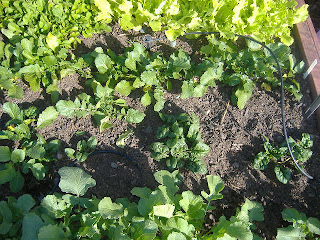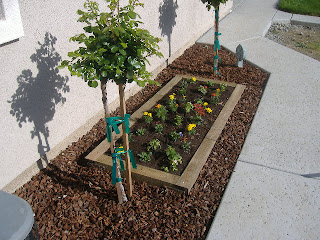Hmm...
Let's just roll that one around in the back of ye olde cranium for a second or two -- shall we?
 During my eons of professional radio broadcasting education at Fresno State University -- the all-knowing professors instructed us to write flowery prose that created an image in the listener's mind. Instead of the line; "it rained real hard here today," we came up with image provoking lines of; "there's a small lake forming at the intersection of Shaw and Cedar Avenues..."
During my eons of professional radio broadcasting education at Fresno State University -- the all-knowing professors instructed us to write flowery prose that created an image in the listener's mind. Instead of the line; "it rained real hard here today," we came up with image provoking lines of; "there's a small lake forming at the intersection of Shaw and Cedar Avenues..."Imagine the image that comes to mind when you think of the phrase: "A Lizard's Ball Sack."
On second thought -- don't.
Yet -- that is how the "significant other" of a well-known Sacramento gardener describes the "look" of an artichoke that is slowly emerging from the center of an artichoke plant. After hearing that line -- suddenly my excitement vanished. My taste for all things "artichoke" went south (probably to Fresno). All I could think of was: Look at Bold Line Above.
 First -- I really don't know what a lizard's private parts look like. Secondly -- I really don't want to know. Yes -- we do have small lizards that scamper about here in the wilds of North Natomas. No -- I am not inspecting the private parts of said lizard. And -- in case you were wondering -- no -- I'm not about to "go there."
First -- I really don't know what a lizard's private parts look like. Secondly -- I really don't want to know. Yes -- we do have small lizards that scamper about here in the wilds of North Natomas. No -- I am not inspecting the private parts of said lizard. And -- in case you were wondering -- no -- I'm not about to "go there."I don't think the lizard would appreciate the inspection either -- but that's just a guess on my part. I haven't questioned a lizard lately. Have you?
Image provoking comments aside -- I don't think I'm going to surprise anyone with the statement of: Spring Has Sprung. It's fairly obvious. Vast fields of yellow mustard are blooming like mad in North Natomas. The daffodils popped early in February and now the tulips have shown up. The shower of blossoms that emerged from the Santa Rosa plum has come and gone -- and now? We have artichokes.
What's the big deal? Well -- number one -- I think this is the first time I've seen them pop this early. Usually? The first buds on an artichoke plant don't emerge until early to mid April. By the time May and June rolls around? It's fresh artichoke season in the Sacramento Valley. It does coincide somewhat with the start of artichoke harvesting efforts on the coast -- which means the grocery store headlines of "Artichokes: Five for $5" isn't all that far off.
 But -- again -- I'm partial to what comes straight out of my backyard. I grew them. I know exactly what I put into them. I know exactly what I'm getting. And what I'm getting is some of the best artichokes you'll find anywhere. My guess is Venus and I will be harvesting the largest 'chokes in another week or two. It sort of depends upon the weather.
But -- again -- I'm partial to what comes straight out of my backyard. I grew them. I know exactly what I put into them. I know exactly what I'm getting. And what I'm getting is some of the best artichokes you'll find anywhere. My guess is Venus and I will be harvesting the largest 'chokes in another week or two. It sort of depends upon the weather.Speaking of the weather -- the series of rainstorms that is supposed to hit the Sacramento area this week is coming at an opportune time for backyard artichoke enthusiasts such as myself. I've discovered through experimentation that a heavy dose of water and fertilizer through the prime growing months results in large harvests of not only large artichokes -- but 'chokes that are just as tender.
Yes -- you'll still get artichokes without the increased attention to water and fertilization. The first harvest will still be pretty good. But the second, third and dare I say fourth, harvests will result in artichokes that are smaller in size -- and worse yet -- tough to chew on. How tough? How much do you like chewing on leather?
The wonderful wife that is Venus and I are sharing fertilization duties this year. The lady has hit upon a super-secret (so secret that she won't even tell me) mix of liquid organic fertilizers and I have been spreading nitrogen-rich -- time-release fertilizers such as Osmocote and other pelleted plant foods.
Is there such a thing as too much love for artichokes? If there is -- we haven't found it yet. Lord knows -- we're trying various experiments from year to year. It just doesn't seem to matter much. The more love that you show artichokes? The more love that they will show you in terms of a prolonged harvest.
How long will the harvest be? That depends upon Mother Nature. If the Grand Dame provides us with pleasant spring-time temperatures in the mid 70's to lower 80's -- you can stretch an artichoke harvest for three months. BUT -- the moment the mercury rises above 90? Kiss the season goodbye. The large plants don't like the heat much.
At that point -- they shut down -- die back -- and wait for the cooler breezes of fall. That's when the life cycle begins anew.
As for varieties? That's a good question. Venus and I know we have different varieties of artichokes that are growing out of the same bed. They're easy to spot. But the names were lost years ago. The artichokes that you see in these pictures started from four starter plants that were purchased from an Elk Grove area nursery in the spring of 2003.
 They have survived year after year after year of abuse. They have even survived a transplant from one backyard to another. Just like the old Timex watch -- "they take a licking and keep on ticking."
They have survived year after year after year of abuse. They have even survived a transplant from one backyard to another. Just like the old Timex watch -- "they take a licking and keep on ticking."Strangely -- that line brings back the image of a lizard's ball sack.
Pinkston -- clearly -- wants to change the subject.
















